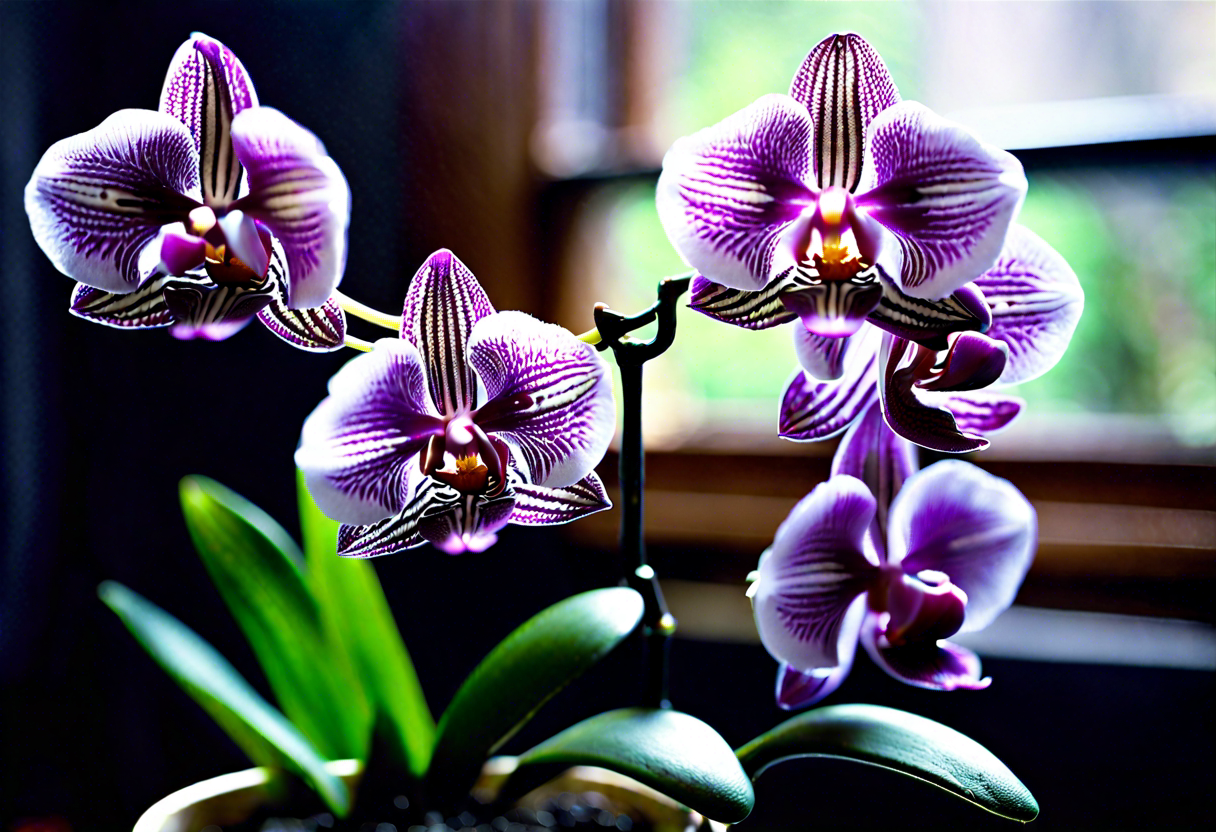The Basics of Growing Orchids at Home
Orchids are a popular choice for home gardeners due to their vibrant blooms and unique, exotic appearance. With a little knowledge and the right conditions, you can successfully grow these beautiful plants in your own home. Here are the basics of growing orchids at home.
1. Choose the Right Orchid
There are thousands of orchid species and hybrids available, each with its own specific requirements. When choosing an orchid for your home, consider factors such as light levels, temperature, and humidity. Some popular orchid species for beginners include Phalaenopsis, Cattleya, and Dendrobium.
2. Provide the Right Lighting
Light is crucial for orchid growth and blooming. Most orchids thrive in bright, indirect light. Place your orchids near a north or east-facing window where they can receive filtered sunlight. Avoid placing them in direct sunlight, as this can scorch their leaves.
3. Ensure Proper Temperature and Humidity
Orchids prefer temperatures that range between 65-85°F (18-29°C) during the day and slightly cooler temperatures at night. Some orchid species require a period of cool temperatures to initiate bloom. To maintain the right humidity levels, you can place your orchids on a tray with water and pebbles or use a humidifier.
4. Water Properly
Overwatering is one of the most common mistakes when growing orchids. Orchids should be watered only when the potting medium feels dry to the touch. Avoid allowing the orchid’s roots to sit in water, as this can lead to root rot. It’s also important to use a well-draining potting mix specifically formulated for orchids.
5. Fertilize Regularly
Orchids require regular feeding to ensure healthy growth and blooming. Use a balanced orchid fertilizer and follow the manufacturer’s instructions for application rates. It’s generally recommended to fertilize every two weeks during the growing season and reduce frequency during periods of dormancy.
6. Repot When Necessary
Orchids should be repotted every one to two years or when the potting medium breaks down. Use a suitable orchid pot and fresh potting mix. Gently remove the orchid from its current pot, trim any dead or decaying roots, and repot it into the new container, ensuring good root contact with the fresh medium.
7. Watch for Pests and Diseases
Common orchid pests include aphids, mealybugs, and spider mites. Regularly inspect your orchids for signs of pests or diseases, such as yellowing leaves, distorted growth, or webs. If a problem is detected, take immediate action using appropriate organic or chemical controls.
8. Enjoy the Blooms
With patience and proper care, your orchids will reward you with stunning blooms. Be sure to take the time to enjoy their beauty and delicate scent. Orchid blooming periods can vary depending on the species, so do some research to know what to expect.
By following these basic guidelines, you can experience the joy of growing orchids at home and enjoy their exquisite beauty all year round. Happy orchid growing!
Choosing the Right Orchid Species for Your Home
Orchids are known for their exquisite beauty and unique charm, making them a popular choice for home cultivation. However, with over 30,000 known species and countless hybrids, it can be overwhelming to choose the right orchid species for your home. To help narrow down your options, consider the following factors:
Climate Compatibility
One of the most important considerations when selecting an orchid species is its climate compatibility with your home. Orchids have different temperature and humidity requirements, so it’s crucial to ensure that your growing environment matches the species’ needs. Some orchids thrive in warm and humid conditions, while others prefer cooler and drier climates. Research the specific requirements of each species to determine if it aligns with your home’s climate.
Light Requirements
Light is another crucial factor for orchid growth and blooming. Different orchid species have varying light needs, ranging from bright indirect light to full sun exposure. Assess the lighting conditions in your home and choose orchids that can thrive under those conditions. Consider factors such as window orientation, the presence of shading structures, and the availability of artificial lighting if needed.
Size and Growth Habit
Orchids come in a wide range of sizes and growth habits, from miniature species that fit perfectly on windowsills to large plants that require more space. Consider the available space in your home and choose orchids that fit well within your desired location. Some orchids grow upright, while others have trailing or cascading growth habits. Consider the aesthetics and functionality of the chosen species’ growth habit within your home.
Care Requirements
Consider your level of experience and commitment to orchid care when selecting a species. Some orchids are more demanding and require specific care routines, while others are more forgiving and adaptable. If you’re a beginner, opt for orchids that are known to be easy to care for and that have a higher chance of success. As you gain experience and confidence, you can gradually expand your collection to include more challenging species.
Desired Blooming Period
Orchids bloom at different times throughout the year, with some species blooming only once a year and others blooming multiple times. Consider the desired blooming period when choosing orchid species. If you prefer a continuous display of blooms, select varieties that have a longer blooming period or multiple flowering cycles.
By taking into account these factors, you can narrow down the options and choose the right orchid species for your home. Remember to do thorough research, consult with experienced orchid growers if possible, and experiment with different species to find the ones that thrive best in your specific growing conditions.
Essential Orchid Care Tips for Beginners
Growing orchids at home can be a rewarding and fulfilling experience. However, caring for these delicate flowers requires some specialized knowledge and attention. If you are a beginner and new to orchid cultivation, here are some essential tips to help you get started and ensure that your orchids thrive.
1. Light: Orchids need bright but indirect light to grow. Place them near a window with filtered sunlight or use artificial grow lights to provide the necessary light intensity. Avoid direct sunlight as it can scorch the leaves and flowers.
2. Temperature and Humidity: Orchids prefer a warm and humid environment. Most orchid species thrive within a temperature range of 60-85°F (15-29°C) during the day and a slightly cooler temperature at night. Maintain humidity levels between 40-70% by using a humidifier, placing a tray of water near the plants, or misting them regularly.
3. Watering: Proper watering is crucial for orchid care. Most orchids prefer to dry out slightly between waterings, so it’s important to strike a balance. Water them thoroughly but allow the potting medium to dry out before watering again. Avoid overwatering, as it can lead to root rot.
4. Potting Medium: Orchids have different potting needs based on their species and growing conditions. Use a well-draining and porous potting medium like orchid bark, sphagnum moss, or a mixture of both. Avoid regular potting soil, as it retains too much moisture and can suffocate the roots.
5. Fertilizing: Orchids have unique nutritional requirements. Use a specialized orchid fertilizer with a balanced formula, such as a 20-20-20 or 10-10-10 ratio. Feed your orchids at half the recommended strength every 2-3 weeks during the growing season, and reduce or stop fertilizing during the dormant period.
6. Air Circulation: Good air circulation is essential for orchid health. This helps prevent fungal or bacterial diseases and ensures adequate gas exchange for the roots. Place fans near the orchids or open windows periodically to maintain proper airflow.
7. Repotting: Orchids generally need to be repotted every 1-2 years to prevent overcrowding and refresh the potting medium. Choose a pot that is just slightly larger than the current one, and gently remove the orchid from its old pot. Trim any dead or damaged roots and repot the orchid using fresh potting medium.
8. Pest Control: Orchids can sometimes attract pests like aphids, mealybugs, or scale insects. Monitor your plants regularly and take immediate action if you spot any pests. Use natural pest control remedies or commercial insecticides specifically formulated for orchids.
9. Patience and Observation: Growing orchids takes time and patience. Each species has different care requirements, so it’s essential to observe your plants closely. Learn to understand their unique needs, and make adjustments to their care routine accordingly.
By following these essential care tips, even beginners can successfully grow orchids at home. Remember, orchids are resilient and forgiving plants, so don’t be discouraged if you encounter some challenges along the way. With care, patience, and a bit of green thumb, you’ll be rewarded with stunning blooms and a flourishing orchid collection.
The Ideal Growing Environment for Orchids
Creating the ideal growing environment is crucial for successfully growing orchids at home. These delicate plants require specific conditions to thrive and produce beautiful blooms. By understanding their natural habitat and implementing the right techniques, you can create an environment that mimics their needs and ensures their health and growth. Here are some essential factors to consider when setting up the perfect growing environment for your orchids.
1. Light: Orchids require the right balance of light to grow and bloom. Place them near a bright window with indirect sunlight. Orchids thrive in bright, filtered light, but direct sunlight can burn their leaves. Observe the light conditions in your home and choose a spot that provides the right amount of light for your specific orchid species.
2. Temperature: Orchids thrive in specific temperature ranges, depending on their species. Most orchids prefer a daytime temperature between 70-85°F (21-29°C) and a slightly cooler temperature at night, around 60-65°F (15-18°C). Provide proper ventilation to prevent excessive heat buildup, especially during the summer months.
3. Humidity: Orchids are native to tropical regions and require high humidity to thrive. Place a tray filled with water near your orchids or use a humidifier to increase humidity levels. Misting the leaves regularly can also provide additional moisture, but avoid wetting the flowers as it can cause damage or fungal diseases.
4. Air Circulation: Good air circulation is essential for orchids to prevent the growth of fungal diseases. Place a fan nearby to create gentle air movement. Avoid placing orchids in drafty areas or near air conditioning vents, as these can cause temperature fluctuations and stress the plants.
5. Potting Medium: Orchids have unique potting requirements. They prefer loose, well-draining potting mediums such as orchid bark, sphagnum moss, or a mix of the two. This allows for proper aeration and prevents waterlogged roots. Avoid using regular potting soil, as it retains too much moisture and can lead to root rot.
6. Watering: Orchids require careful watering to avoid overwatering or underwatering. Water them thoroughly when the potting medium starts to dry out, but make sure the excess water drains out completely. Empty the water collected in the tray after 30 minutes to prevent the roots from sitting in water.
7. Fertilizing: Provide regular feeding to your orchids to replenish the nutrients in the potting medium. Use a balanced orchid fertilizer with a ratio of 20-20-20 or a specialized orchid fertilizer. Follow the instructions on the packaging and adjust the frequency based on your orchid species and the potting medium used.
By incorporating these essential factors into your orchid growing routine, you can create the ideal environment for their growth and bloom. Remember to research the specific needs of your orchid species, as their requirements may vary. With proper care and attention to detail, you can enjoy the beauty and elegance of orchids in your own home.
Common Orchid Problems and How to Solve Them
Growing orchids at home can be a rewarding and beautiful experience. However, like any plant, orchids can encounter certain problems that require attention and care. By understanding these common issues and knowing how to address them, you can ensure the health and longevity of your orchids.
One of the most common problems faced by orchid enthusiasts is overwatering. Orchids are tropical plants that thrive in moist conditions but do not tolerate excessive moisture. Overwatering can lead to root rot, which is detrimental to the plant’s overall health. To avoid this, make sure to water your orchids only when the top inch of the potting mix feels dry to the touch. Additionally, using a well-draining potting medium specifically formulated for orchids can help prevent waterlogged roots.
Poor drainage can also cause issues for orchids. If the potting mix doesn’t drain well, excess moisture can accumulate, leading to root rot or fungal diseases. To improve drainage, consider adding materials like bark chips or perlite to the potting mix. These will enhance airflow and prevent water from becoming trapped around the roots.
Another common problem for orchid growers is inadequate humidity. Orchids thrive in humid environments, and low humidity levels can result in stunted growth and wilting flowers. To increase humidity around your orchids, you can mist them regularly or use a humidifier in the growing area. Placing the orchids on a tray filled with pebbles and water can also help create a more humid microclimate.
Poor lighting is another issue that can affect the health and blooming of orchids. These plants require bright, indirect light to thrive. If your orchids aren’t receiving enough light, they may produce weak, pale growth and fail to bloom. Consider placing them near a north or east-facing window where they can receive plenty of indirect sunlight. If natural light is limited, you can supplement it with artificial grow lights specifically designed for orchids.
Pests are another common enemy of orchid enthusiasts. Mealybugs, aphids, and spider mites are some of the pests that can infest orchids and cause damage. Regularly inspect your plants for signs of pests and promptly take action if you notice any. Using insecticidal soap or horticultural oil can help control these pests and prevent further damage to your orchids.
By being proactive in addressing these common orchid problems, you can ensure that your plants thrive and flourish in your home. Remember to monitor watering, improve drainage, provide adequate humidity, offer proper lighting, and promptly handle any pest infestations. With the right care and attention, you can enjoy the beauty of orchids in your home for years to come.
Conclusion
Growing orchids at home can be a rewarding and fulfilling experience for any plant enthusiast. Whether you are a beginner or have some experience with gardening, following the basics of orchid care is essential to ensure the successful growth of these delicate and beautiful flowers.
Choosing the right orchid species for your home is crucial for their overall well-being. Consider factors such as light requirements, temperature preferences, and the level of care needed before making a purchase. With a wide variety of orchids available, you can select the ones that align with your preferences and the conditions you can provide.
Once you have selected your orchids, it is important to understand and implement the essential care tips for beginners. These include providing adequate light, watering properly, ensuring proper drainage, and maintaining the ideal humidity levels. Orchids have specific requirements, and by providing them with the right care, you can encourage healthy growth and vibrant blooms.
Creating the ideal growing environment for orchids involves replicating their natural habitat as closely as possible. You can achieve this by using the right potting medium, which provides good airflow and drainage. Additionally, maintaining the appropriate temperature and humidity levels helps mimic their natural tropical environment. Investing in a humidifier or placing a tray with water near the orchids can help maintain the required humidity levels.
Even with proper care, orchids can sometimes face common problems such as pests, diseases, and cultural issues. Identifying these issues early on is crucial for effective problem-solving. Regularly inspect your orchids for signs of pests like aphids or spider mites and take immediate action if detected. Diseases like root rot can be prevented by ensuring proper ventilation and avoiding overwatering. Moreover, staying vigilant about their specific cultural needs, such as light intensity and temperature fluctuations, can prevent issues before they occur.
Growing orchids at home can be both a challenging and rewarding endeavor. By understanding the basics of orchid care, choosing the right species, creating the ideal growing environment, and addressing common problems, you can cultivate thriving orchids that grace your home with their exquisite beauty and fragrance. With patience, dedication, and a bit of knowledge, you can embark on an orchid-growing journey that brings joy and satisfaction as you witness your orchids flourish and thrive. So, start your orchid-growing adventure today and experience the wonders of nurturing these mesmerizing flowers right in the comfort of your own home.


